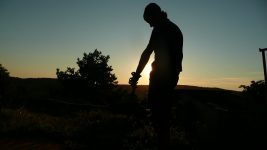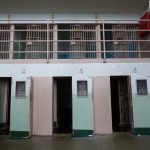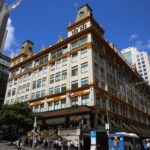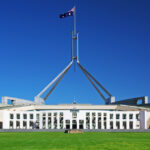They can’t take my home! Man chains himself to machinery to protest compulsory acquisition

A letter arrives in the mail box one day telling its owner that the government is going to “compulsorily acquire” his home.
Over 40 homes of his neighbours get the same letter.
The government has earmarked the area for demolition to make way for a new project.
The residents unite and plan to fight to keep their homes.
While this might sound like the opening of the classic Australian movie “The Castle”, it is a real-life scenario currently playing out in Sydney’s inner west.
Many residents in the region are unhappy about the proposed WestConnex motorway, especially those who have to pack up and find a new place to live.
Dr Peter Ross is one of those whose home may soon be acquired and demolished.
He is an academic at the University of Sydney, where he teaches Spanish and Latin American studies.
But on the 2nd of February, he was one of more than a thousand residents that turned up to Newtown’s busy street, King Street, to protest.
Unfortunately for the residents, the demonstration did nothing to change the situation and Ross planned then decided that he would take further protest action.
At 6.30am on the 9th of February, Ross arrived on Campbell Street, St Peters.
He entered private property and used a metal tube and chains to attach himself to parts of the machinery of a drilling rid.
He was cheered on by his supporters when police arrived.
Police finally cuts him free a few hours later, arrested him be arrested and took him away in a police van.
Ross was charged under the Inclosed Lands Protection Act (“the Act”) and is scheduled to appear in Newtown Local court on the 5th of March.
Along with him, a photographer who entered the site to take photographs was also arrested and charged under the same Act.
What is the Inclosed Lands Protection Act?
The Inclosed Lands Protection Act (the “Act”) was essentially designed to make trespassing a statutory criminal offence in certain circumstances.
“Inclosed lands” are any public or private lands that are surrounded by a fence, wall, river, cliff or other boundary.
They include any government school, hospital, nursing home or child care service.
The Act makes any unauthorised entry, or the refusal to leave after being asked to, a criminal offence, and there are several other offences listed in the Act that can be connected with entering inclosed lands.
The penalty for unlawfully entering inclosed land is a fine, which can either be dealt with by an on-the-spot fine, or in court – the choice is up to police.
If the matter goes to court and a fine is given, there will also be a criminal conviction.
Trespassers may also be obliged to pay the owner of the property for any damage caused.
Rights when protesting:
Politicians have criticised the protests, saying that residents should be happy with the proposed development.
But they’re probably not among those losing their homes.
Those who intend to participate in demonstrations should be aware that in NSW, we do not have a right to protest.
In fact, in order to conduct a protest, we must obtain permission from the police.
The procedure for obtaining permission is contained in sections 22 to 27 of the Summary Offences Act 1998 (NSW).
If we do not get permission, the event is considered to be an “unlawful assembly”, and anyone who knowingly participates may be charged with a criminal offence under section 545C(1) of the Crimes Act 1900 (NSW).
The maximum penalty for that offence is 6 months imprisonment and/or a $550.00 fine.
So although “a person’s home is their castle”, residents in NSW can get into a lot of trouble trying to protect what is meant to be rightfully their’s.






